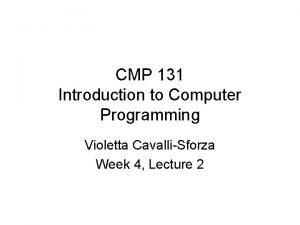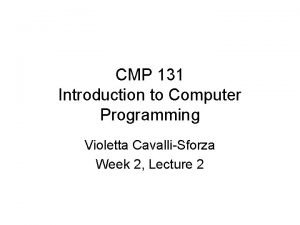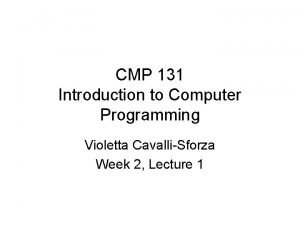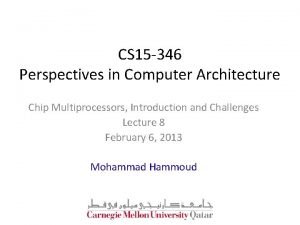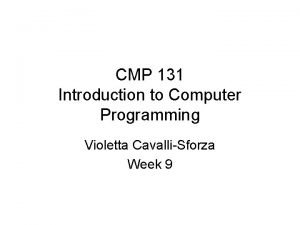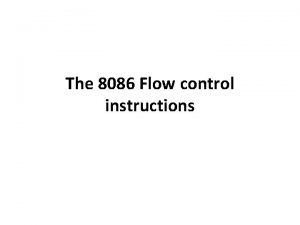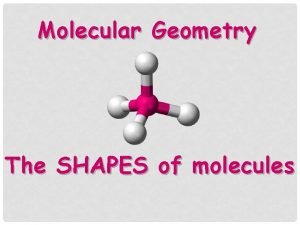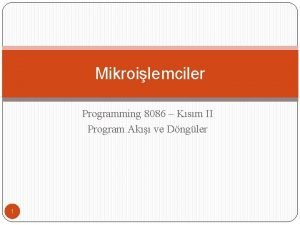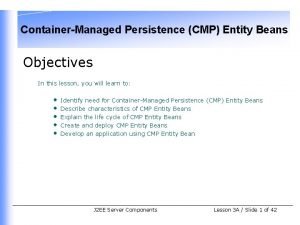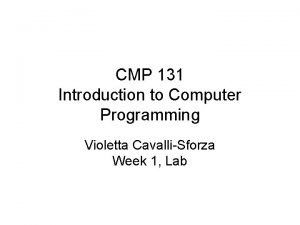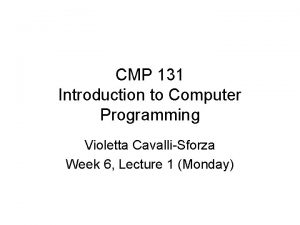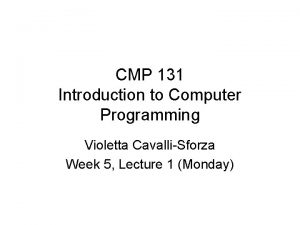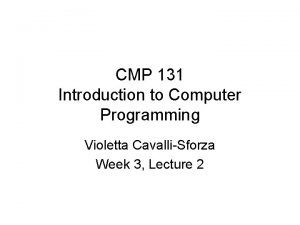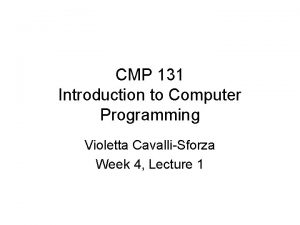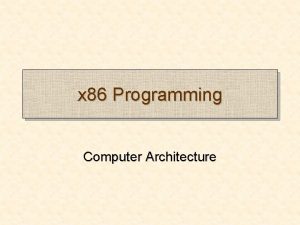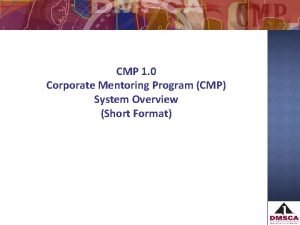CMP 131 Introduction to Computer Programming Violetta CavalliSforza



















- Slides: 19

CMP 131 Introduction to Computer Programming Violetta Cavalli-Sforza Week 6, Lecture 1 (Monday)

TODAY • Midterm exam will be Monday April 23 • Still waiting for programs from homework #2 • Go over remainder homework #2, as part of review for midterm exam – Formatting with write, writeln • New material for today/this week/next week: – Selection. Making decisions. – Different types of choices: Yes/No choice. Either/or choice. Multiple choices. – Boolean expressions – Conditional statements in some detail – Nesting conditional statements

Homework #2 Review

Exercises 1. 4, # 2 – 12 points • Valid: – – – b) Payroll c) Room 222 e) A f) A 1 k) List. Of. Employees • Invalid: – – – – a) 7 up d) Name List g) 1 A h) Time&Place i) CONST j) X*Y l) Lima, Ohio

Exercises 1. 4, # 4 – 3 points • The three main sections of a Pascal program are: – Program heading – Declaration section – Executable section / program body • You tell me what is in each part.

Exercises 1. 4, # 6 – 6 points a. CONST Company : ‘General Motors’; VAR Salary : real; b. VAR Age = 25; c. VAR Days : integer; Swap order Ch : char; CONST Name = ‘John Smith’;

d. CONST Car : ‘Cadillac’; e. CONST Score : integer; f. VAR X, Y, Z : real; Score, Num : integer; This is okay!

Exercises 1. 4, # 7 – 2 points • Semicolon is a statement separator • Semicolon is not needed before an END because END is not a statement • A semicolon is also not needed before an ELSE (we’ll see this later) Stmt ; stmt separator (correct) Stmt ; stmt ; terminator (accepted)

Exercises 1. 5, # 16 – 6 points What type of data is appropriate for each of the following: a. Your age – integer b. Your grade point average (GPA) – real c. Your name – string (not char) d. A test score – integer or real e. The average test score – real f. Your grade – char, integer, real, string

Part c) • Following the example of calculating the mean that we used in class during Week 3 of the course, develop the problem statement, analysis, and design for a program that calculates the maximum of a set of numbers. You don't know how many numbers you will be given. You can assume that all numbers will be greater than 0. • Use example from Week 3. 1, Slide 29.

Maximum of N PROCESSING: called a sentinel value because it guards the loop Initialize Old to 0 Prompt for New number Read New while New is not equal to -99999 do: IF New > Old THEN Old : = New Prompt for New Read New Write the value of New {New stores the maximum value} This is also an example of indefinite looping : You DO NOT know how many times you go around the loop until you finish.

Minimum of N (very similar to Maximum) PROCESSING: called a sentinel value because it guards the loop Initialize Old to Max. Int Prompt for New number Read New while New is not equal to -99999 do: IF New < Old THEN Old : = New Prompt for New Read New Write the value of New {New stores the minimum value} This is also an example of indefinite looping : You DO NOT know how many times you go around the loop until you finish.

New Material

Types of Statements • Input/Output : for user-program communication • Assignment : to store (intermediate) results • Control Structures: to determine which other statements are executed and when – conditional or selection statements : content is executed once, if at all – looping, repetition, or iteration statements : content is executed several times

What about computations? • Computations are performed through expressions. Examples: – 3+X – a<b • If you don’t use them in other statements you might as well not perform them – Assign them to variables with an assignment statement – Ouput them via output statements – Use them in control structures to determine what statements are executed.

Looping/Iteration/Repetition Statements • • Three terms for the same idea: Performing an action or a set of actions a number of times Fixed or definite repetition : – – • You know how many repetitions before you enter the loop Also counter-controlled repetition Pascal uses FOR loop Example : printing out a rectangle Variable or indefinite repetition : – You don’t know how many repetitions you will do before you enter the loop – Sentinel-controlled loops – Pascal uses two types of loops: • WHILE loop – Pretest loop : condition is tested at the top of the loop and therefore before ever entering the loop – Body of loop executed 0 or more times • REPEAT loop – Postest loop : condition is tested at the top of the loop – Body of loop executed at least one time in order to reach the condition Examples of all of these in slides from Week 3. 1. • We will look at these in more detail later

Conditional / Selection Statements • The basic idea, at the level of the algorithm, is that there is a choice to be made • Three types of choices: 1. Yes/no choice. If yes, do something, otherwise do nothing 2. Either/or choice. A 2 -way choice. Do something different in each case. 3. Multiple choice. An N-way chice. Do something different in each case. It can be expressed as a series of 2 -way choices. • Like most programming languages, Pascal provides a way of expressing these choices.

Combining Statements • The various types of statements can be combined in many ways. • In particular, control statements can be nested inside each other. Nesting is a visual/physical relationship but also a control relationship. – One loop can be performed inside another – A conditional statement can control whether a loop is executed – A conditional statement can be executed several times inside a loop • When several statements are controlled by another statement we often use BEGIN and END to create compound statements

Example: Drawing Rectangles FOR I : = 1 to Height BEGIN FOR J : = 1 TO Width write(‘*’); writeln; END This FOR loop controls only the input/output statement “write(‘*’)”. This FOR loop controls a compound statement enclosed by the BEGIN and END. The inner FOR statement is nested inside the outer FOR statement.
 Violetta cavalli-sforza
Violetta cavalli-sforza Violetta cavalli sforza
Violetta cavalli sforza Cmp programming
Cmp programming Cmp in computer architecture
Cmp in computer architecture Personajes de violetta nombres
Personajes de violetta nombres Violetta wagner
Violetta wagner Violetta cavalli-sforza
Violetta cavalli-sforza Violetta cavalli sforza
Violetta cavalli sforza Violetta hoffmann
Violetta hoffmann Violetta cavalli-sforza
Violetta cavalli-sforza Python programming an introduction to computer science
Python programming an introduction to computer science Perbedaan linear programming dan integer programming
Perbedaan linear programming dan integer programming Greedy vs dynamic
Greedy vs dynamic System programming
System programming Linear vs integer programming
Linear vs integer programming Perbedaan linear programming dan integer programming
Perbedaan linear programming dan integer programming Cmp in microprocessor 8086
Cmp in microprocessor 8086 Axe notation examples
Axe notation examples Assembly cmp komutu
Assembly cmp komutu Cmp entity bean
Cmp entity bean
